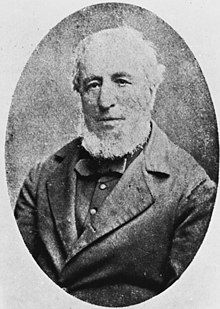Edward Davy
Edward Davy | |
|---|---|
 | |
| Born | 16 June 1806 Ottery St Mary, Devon, England |
| Died | 26 January 1885 (aged 78) |
| Nationality | British |
| Known for | Telegraphy |
| Scientific career | |
| Fields | Physics |
Edward Davy (16 June 1806 – 26 January 1885) was an English physician, scientist, and inventor who played a prominent role in the development of
Davy was born in Ottery St Mary, Devonshire, England, son of Thomas Davy (medical practitioner and house surgeon at Guy's Hospital, London). Edward Davy was educated at a school run by his maternal uncle in Tower Street, London. He was then apprenticed to Dr C. Wheeler, house surgeon at St Bartholomew's Hospital.[2] Davy won the prize for botany in 1825, was licensed by the Worshipful Society of Apothecaries in 1828 and the Royal College of Surgeons in 1829.[2] Soon after graduating, Davy began trading as an operative chemist under the name of Davy & Co. In 1836 he published a small book Experimental Guide to Chemistry, at the end of which was a catalogue of goods supplied by his firm.[1][2] Davy is distantly related to Humphry Davy.[3]
Davy published Outline of a New Plan of Telegraphic Communication in 1836 and carried out telegraphic experiments the following year. He demonstrated the operation of the telegraph over a mile of wire in
Davy apparently had some thoughts on a wireless telegraphy system. This system was an electrical-acoustic hybrid, but Davy's writings are far from clear exactly what was intended and nothing was put into practice. According to John Fahie, the best interpretation of Davy's concept is a chain of sound transmitters, such as a bell, and focused sound reflectors tuned to the transmission note to receive the signal. At each intermediate station the sound is renewed using electrical repeaters incorporating Davy's relay.[6]
Davy's marriage broke down shortly after the Regent's Park demonstration and he found himself in litigation with his wife and her creditors. In August 1838 he fled to Australia to avoid them, giving up work on the telegraph in the process.[4][3] His telegraph patents were purchased by the Electric Telegraph Company in 1847 for £600,[5] mostly in order to obtain the rights to the electric relay invented by Davy.[7] The rest of his telegraph system was not wanted, other than to prevent competitors from using it.[8] He was editor of the Adelaide Examiner from June to July 1842 and was elected president of the Port Adelaide Mechanics' Institute at its inaugural meeting in 1851.[1] Davy was a director and manager of the Adelaide Smelting Company and became chief assayer of the Government Assay Office in Adelaide in February 1852.[1]
Davy was appointed assay master in Melbourne in July 1853[2] until the office was abolished in October 1854. For a short while, he took up farming near Malmsbury, Victoria then moved into Malmsbury where he practised as a physician for the rest of his life. He was three times mayor of Malmsbury.[1]
References
- ^ a b c d e f g
Gibberd, William (1966). "Edward Davy". ISSN 1833-7538. Retrieved 31 August 2014.
- ^ a b c d Serle, Percival (1949). "Edward, Davy". Dictionary of Australian Biography. Sydney: Angus & Robertson. Retrieved 31 August 2014.
- ^ ISBN 0905118839.
- ^ ISBN 140084777X.
- ^ a b "Edward Davy". Australian Science Archives Project. Retrieved 7 June 2012.
- ISBN 1108026869(reprint from 1901).
- OCLC 655205099.
- ^ Steven Roberts, Distant Writing, ch. 4, "The Electric Telegraph Company", archived 1 July 2016.
External links
- Biography[permanent dead link] from the Institution of Engineering and Technology.
- Biography Archived 3 March 2016 at the Wayback Machine from AIM25 (Archives in London and the M25 area)
- Copyrighted photograph[permanent dead link] from the State Library of South Australia.
- Obituary notice in The Argus from National Library of Australia archive
